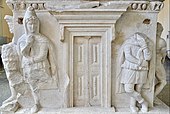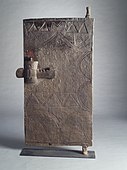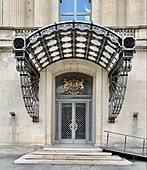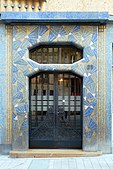တံခါး
တံခါးဆိုသည်မှာ အခန်း သို့မဟုတ် နေရာတစ်ခုခုအတွင်းသို့ ဝင်ရောက်ရန်အတွက် လူပုဂ္ဂိုလ်တစ်ဦးက ဖွင့်နိုင်/ပိတ်နိုင်သော မာကျော၍ကြီးမားသည့် အရွက်တပ်ဆင်ထားသော အရာဝတ္ထုတစ်ခုခုကို ဆိုလိုခြင်းဖြစ်သည်။ တံခါးကို အိမ်များနှင့် အဆောက်အဦများတွင် တွေ့ရှိနိုင်သည်။ ထို့မျှမက မော်တော်ကားနှင့် လှောင်အိမ်များတွင်လည်း တံခါးအား တွေရှိနိုင်သေးသည်။ တံခါး တပ်ဆင်ရခြင်း၏ ရည်ရွယ်ချက်များမှာ -
- လူပုဂ္ဂိုလ်၊ တိရစ္ဆာန်များနှင့် အရာဝတ္ထုများ ဖြတ်သန်းသွားလာနိုင်ရန်၊ အချို့တံခါးများကိုမူ အရေးပေါ်အခြေအနေ၌သာ အသုံးပြုသည်(အရေးပေါ်ထွက်ပေါက်အား ဖတ်ရှူရန်)။
- ပြင်ပမှ လေပူ လေအေးအား ထိန်းသိမ်းရန် (ရေခဲသေတ္တာရှိ တံခါးသည် အတွင်းလေအား ထိန်းသိမ်းရန်ဖြစ်သည်)။
- အတွင်း/အပြင်ကိစ္စများအား မြင်နိုင်မှုမရှိစေရန် (လုံခြုံရေးနှင့် ဆူညံမှု မရှိစေရန်)။
- ကား သို့မဟုတ် ယာဉ်အတွင်းမှ အပြင်သို့ ပြုတ်မကျစေရန်။
- မည်သူကို၊ မည်သည့်အရာကို ဝင်စေ/ထွက်စေ ပြုလုပ်နိုင်စေရန်။
စသည်တို့ဖြစ်ကြသည်။
တံခါး အမျိုးအစားများ
[ပြင်ဆင်ရန်]
ဆုံလည် တံခါး သည် တံခါးများအား စု၍ ဖွဲ့စည်းထားသည့် တံခါးအမျိုးအစားဖြစ်၍ စက်ဝိုင်းကဲ့သို့ လည်နေပြီး လူပုဂ္ဂိုလ်တစ်ဦးက တွန်းဖွင့်ခြင်းဖြင့် ဖြတ်သန်းသွားလာနိုင်သည်။
ဘလိုင်း တံခါး ဆိုသည်မှာ တံခါးအတု တစ်ခုဖြစ်ပြီး နံရံ၏ အစိတ်အပိုင်းတစ်ခုအဖြစ်တည်ရှိသည်။ လူတို့သည် ဘလိုင်းတံခါးများကို အခန်းလှပရန်အတွက် အသုံးပြုကြသည်။
အပေါ်လိတ် တံခါးအား ဂါးရေ့များတွင် အများဆုံးတွေ့ရတတ်သည်။ ပတ္တာအစား ရောင်ဆွဲ အသုံးပြုပြီး လိတ်တက်စေခြင်းဖြင့် အဆောက်အဦး၏ အပေါ်ပိုင်းတွင် ရှိနေစေသည်။
မီးကာ တံခါးဆိုသည်မှာ မီးဖြတ်သန်းသွားခြင်း မရှိစေအောင် စီမံထားသည့် တံခါးအမျိုးအစားဖြစ်သည်။ အများအားဖြင့် ထူထဲသည့် စတီးလ်အသုံးပြု၍ ပြုလုပ်ထားကြသည်။
ခွေးတိုးပေါက် တံခါး ဆိုသည်မှာ ခွေး၊ ကြောင် စသည့် အိမ်မွေးတိရစ္ဆာန်ငယ်လေးများ ဝင်ထွက်သွားလာနိုင်အောင် ဖန်တီးထားသည့် တံခါးငယ်လေးများကိုခေါ်သည်။ ထိုတံခါးများအား တံခါးမကြီးများ၏အောက်ခြေတွင် ထည့်သွင်းတည်ဆောက်ထားလေ့ရှိသည်။
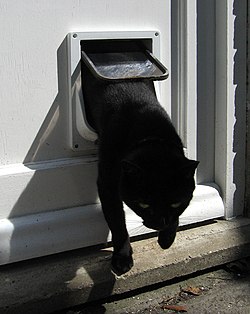
- ကြည့်ရှုလေ့လာနိုင်သော တံခါးများ၏ သမိုင်းကြောင်း အကျဉ်း
-
Fragment from an Ancient Egyptian tomb door, circa 2150 –1981 BC, in the Metropolitan Museum of Art (New York City)
-
Ancient Greek door carved on the Hercules sarcophagus from the Kayseri Archaeology Museum (Kayseri, Turkey)
-
Russian door in Saint Basil's Cathedral (Moscow)
-
Renaissance door in Gdańsk (Poland)
-
Rococo door on Rue Monsieur-le-Prince (Paris)
-
Louis XVI door of the Hôtel Mortier de Sandreville, on Rue des Francs-Bourgeois (Paris)
-
Neoclassical painted double-leaf door, 1790s, by Pierre Rousseau, in the Cleveland Museum of Art (US)
-
African door with lock, late 19th or early 20th century, wood with iron, from Burkina Faso, in the Brooklyn Museum (New York City)
-
A decorated door from the Gandantegchinlen Monastery (Mongolia)
-
Gothic Revival door on Rue Malebranche (Paris)
-
Egyptian Revival door of a mausoleum in the Forest Home Cemetery (Wisconsin, US)
-
Rococo Revival door of the Hôtel de Breteuil (Paris)
-
Romanian Revival door of the Școala Centrală National College on Strada Icoanei (Bucharest)
-
19th century Eclectic Classicist door on Rue La Bruyère (Paris)
-
Beaux-Arts door of the Cantacuzino Palace (Bucharest)
-
Stripped Classicist door of the Royal Palace of Bucharest, now the National Museum of Art of Romania








